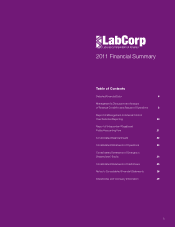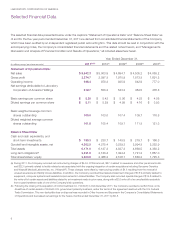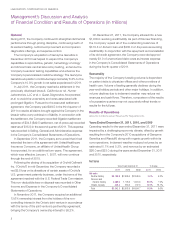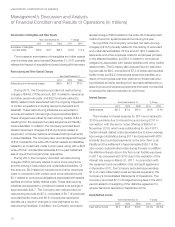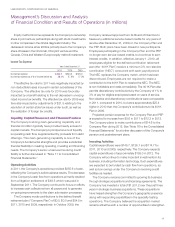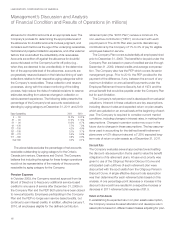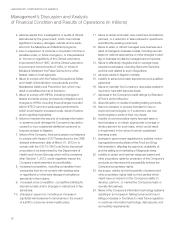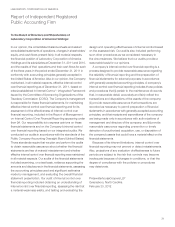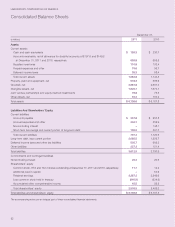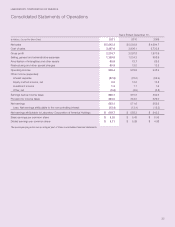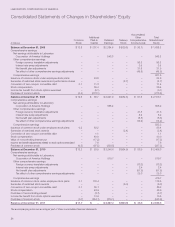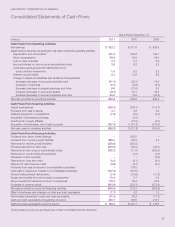LabCorp 2011 Annual Report Download - page 17
Download and view the complete annual report
Please find page 17 of the 2011 LabCorp annual report below. You can navigate through the pages in the report by either clicking on the pages listed below, or by using the keyword search tool below to find specific information within the annual report.15
LABORATORY CORPORATION OF AMERICA
Management’s Discussion and Analysis
of Financial Condition and Results of Operations (in millions)
In June 2011, the FASB issued authoritative guidance
on the presentation of comprehensive income. Specifically,
this literature allows an entity to present components of net
earnings and other comprehensive income in one continuous
statement, referred to as the statement of comprehensive
income, or in two separate, but consecutive statements. The
authoritative guidance eliminates the current option to report
other comprehensive income and its components in the state-
ment of changes in shareholders’ equity. While the authoritative
guidance changes the presentation of comprehensive income,
there are no changes to the components that are recognized
in net earnings or other comprehensive income under current
accounting guidance. The guidance is effective for fiscal years
and interim periods beginning after December 15, 2011. The
Company does not believe the adoption of the authoritative
guidance in the first quarter of fiscal 2012 will have an impact
on its consolidated financial position, results of operations or
cash flows.
In May 2011, the FASB issued authoritative guidance to
achieve common fair value measurement and disclosure
requirements between U.S. generally accepted accounting
principles and International Financial Reporting Standards.
This new literature amends current fair value measurement
and disclosure guidance to include increased transparency
around valuation inputs and investment categorization. The
guidance is effective for fiscal years and interim periods
beginning after December 15, 2011. The Company does not
believe the adoption of the authoritative guidance in the first
quarter of fiscal 2012 will have an impact on its consolidated
financial statements.
Critical Accounting Policies
The preparation of financial statements in conformity with
generally accepted accounting principles requires manage-
ment to make estimates and assumptions that affect the
reported amounts of assets and liabilities and disclosure of
contingent assets and liabilities at the date of the financial
statements and the reported amounts of revenues and
expenses during the reported periods. While the Company
believes these estimates are reasonable and consistent, they
are by their very nature, estimates of amounts that will depend
on future events. Accordingly, actual results could differ from
these estimates. The Company’s Audit Committee periodically
reviews the Company’s significant accounting policies. The
Company’s critical accounting policies arise in conjunction
with the following:
• Revenuerecognitionandallowancesfor
doubtful accounts;
• Pensionexpense;
• Accrualsforselfinsurancereserves;and
• Incometaxes
Revenue Recognition and Allowance for Doubtful Accounts
Revenue is recognized for services rendered when the testing
process is complete and test results are reported to the order-
ing physician. The Company’s sales are generally billed to
three types of payers – clients, patients and third parties such
as managed care companies, Medicare and Medicaid. For
clients, sales are recorded on a fee-for-service basis at the
Company’s client list price, less any negotiated discount.
Patient sales are recorded at the Company’s patient fee
schedule, net of any discounts negotiated with physicians on
behalf of their patients. The Company bills third-party payers
in two ways – fee-for-service and capitated agreements.
Fee-for-service third-party payers are billed at the Company’s
patient fee schedule amount, and third-party revenue is
recorded net of contractual discounts. These discounts are
recorded at the transaction level at the time of sale based on
a fee schedule that is maintained for each third-party payer.
The majority of the Company’s third-party sales are recorded
using an actual or contracted fee schedule at the time of sale.
For the remaining third-party sales, estimated fee schedules
are maintained for each payer. Adjustments to the estimated
payment amounts are recorded at the time of final collection
and settlement of each transaction as an adjustment to
revenue. These adjustments are not material to the Company’s
results of operations in any period presented. The Company
periodically adjusts these estimated fee schedules based
upon historical payment trends. Under capitated agreements
with managed care companies, the Company recognizes
revenue based on a negotiated monthly contractual rate for
each member of the managed care plan regardless of the
number or cost of services performed.
The Company has a formal process to estimate and review
the collectibility of its receivables based on the period of time
they have been outstanding. Bad debt expense is recorded
within selling, general and administrative expenses as a
percentage of sales considered necessary to maintain the


